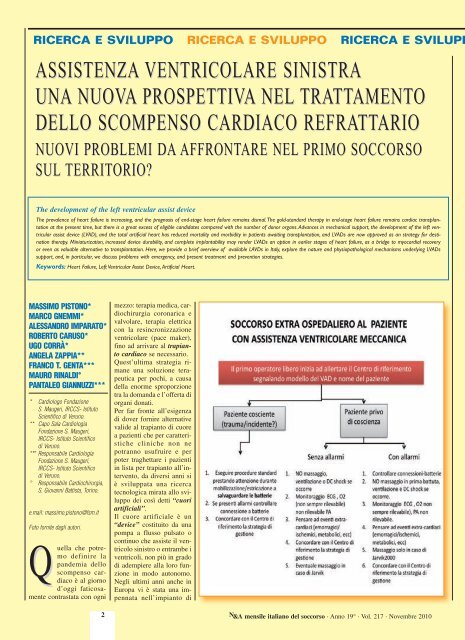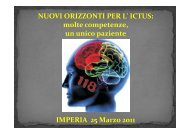Scarica e Leggi la Rivista N&A - Progetto Ictus
Scarica e Leggi la Rivista N&A - Progetto Ictus
Scarica e Leggi la Rivista N&A - Progetto Ictus
You also want an ePaper? Increase the reach of your titles
YUMPU automatically turns print PDFs into web optimized ePapers that Google loves.
RICERCA E SVILUPPO RICERCA E SVILUPPO RICERCA E SVILUPPO<br />
ASSISTENZA VENTRICOLARE SINISTRA<br />
UNA NUOVA PROSPETTIVA NEL TRATTAMENTO<br />
DELLO SCOMPENSO CARDIACO REFRATTARIO<br />
NUOVI PROBLEMI DA AFFRONTARE NEL PRIMO SOCCORSO<br />
SUL TERRITORIO?<br />
The development of the left ventricu<strong>la</strong>r assist device<br />
The prevalence of heart failure is increasing, and the prognosis of end-stage heart failure remains dismal. The gold-standard therapy in end-stage heart failure remains cardiac transp<strong>la</strong>ntation<br />
at the present time, but there is a great excess of eligible candidates compared with the number of donor organs. Advances in mechanical support, the development of the left ventricu<strong>la</strong>r<br />
assist device (LVAD), and the total artificial heart has reduced mortality and morbidity in patients awaiting transp<strong>la</strong>ntation, and LVADs are now approved as an strategy for destination<br />
therapy. Miniaturization, increased device durability, and complete imp<strong>la</strong>ntability may render LVADs an option in earlier stages of heart failure, as a bridge to myocardial recovery<br />
or even as valuable alternative to transp<strong>la</strong>ntation. Here, we provide a brief overview of avai<strong>la</strong>ble LAVDs in Italy, explore the nature and physiopathological mechanisms underlying LVADs<br />
support, and, in particu<strong>la</strong>r, we discuss problems with emergency, and present treatment and prevention strategies.<br />
Keywords: Heart Failure, Left Ventricu<strong>la</strong>r Assist Device, Artificial Heart.<br />
MASSIMO PISTONO*<br />
MARCO GNEMMI*<br />
ALESSANDRO IMPARATO*<br />
ROBERTO CARUSO*<br />
UGO CORRÀ*<br />
ANGELA ZAPPIA**<br />
FRANCO T. GENTA***<br />
MAURO RINALDI°<br />
PANTALEO GIANNUZZI***<br />
* Cardiologo Fondazione<br />
S. Maugeri, IRCCS- Istituto<br />
Scientifico di Veruno.<br />
* * Capo Sa<strong>la</strong> Cardiologia<br />
Fondazione S. Maugeri,<br />
IRCCS- Istituto Scientifico<br />
di Veruno.<br />
* ** Responsabile Cardiologia<br />
Fondazione S. Maugeri,<br />
IRCCS- Istituto Scientifico<br />
di Veruno.<br />
° Responsabile Cardiochirurgia,<br />
S. Giovanni Battista, Torino.<br />
e.mail: massimo.pistono@fsm.it<br />
Foto fornite dagli autori.<br />
Q<br />
uel<strong>la</strong> che potremo<br />
definire <strong>la</strong><br />
pandemia dello<br />
scompenso cardiaco<br />
è al giorno<br />
d’oggi faticosamente<br />
contrastata con ogni<br />
2<br />
mezzo: terapia medica, cardiochirurgia<br />
coronarica e<br />
valvo<strong>la</strong>re, terapia elettrica<br />
con <strong>la</strong> resincronizzazione<br />
ventrico<strong>la</strong>re (pace maker),<br />
fino ad arrivare al trapianto<br />
cardiaco se necessario.<br />
Quest’ultima strategia ri -<br />
mane una soluzione terapeutica<br />
per pochi, a causa<br />
del<strong>la</strong> enorme sproporzione<br />
tra <strong>la</strong> domanda e l’offerta di<br />
organi donati.<br />
Per far fronte all’esigenza<br />
di dover fornire alternative<br />
valide al trapianto di cuore<br />
a pazienti che per caratteristiche<br />
cliniche non ne<br />
potranno usufruire e per<br />
poter traghettare i pazienti<br />
in lista per trapianto all’intervento,<br />
da diversi anni si<br />
è sviluppata una ricerca<br />
tecnologica mirata allo sviluppo<br />
dei così detti “cuori<br />
artificiali”.<br />
Il cuore artificiale è un<br />
“device” costituito da una<br />
pompa a flusso pulsato o<br />
continuo che assiste il ventricolo<br />
sinistro o entrambe i<br />
ventricoli, non più in grado<br />
di adempiere al<strong>la</strong> loro funzione<br />
in modo autonomo.<br />
Negli ultimi anni anche in<br />
Europa vi è stata una im -<br />
pennata nell’impianto di<br />
N &A mensile italiano del soccorso · Anno 19° · Vol. 217 · Novembre 2010



